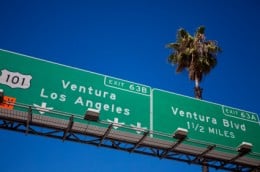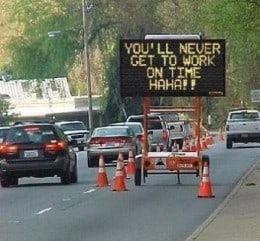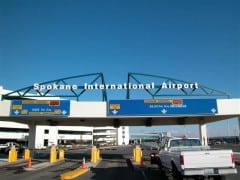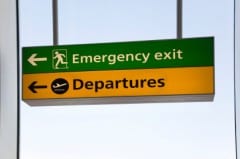While these two types can cross over, Illuminated and Digital Traffic Signs aren’t necessarily the same thing.
Digital Electronic and Illuminated Road, Highway, Traffic, Street Airport Signs
Digital traffic signs are typically lighted with LED’s (Light Emitting Diodes) and may have a small section that shows a number or series of numbers and letters, such as you might see at some airports, or may be an electronic reader board with messages for oncoming motorists.
Illuminated Traffic Signs

Illuminated Traffic Signs, on the other hand, may include digital kinds, but may simply be a signpost that is lighted from below with directional lamps, giving it the appearance of being illuminated. They typically have a sensor that flips the switch on the lights as it gets dark and then reverses the process as daylight arrives in the morning.
As you can see, on the rail below the road signs and to the outside of the service platform there are lights affixed to the rail that shine onto the reflective surface, making it highly visible at night, which is a good thing, especially if you’re new to the area or passing through.
Digital Traffic Signs

Digital Road Signs are different in that they use LED’s, as mentioned earlier, and can look like this. The one on the above is a sign board that is a “message center” type and is programmed remotely with a new message as needed…typically something like “Road Construction starting August 1st and Never Ending…hahaha” or the like.

The one on the above is generally programmed from a booth and will say something like “Open” or “Lot 2 Full” or similar. Obviously, they are more expensive than your standard aluminum panel road sign, especially the message center style…the one on the left, for instance, probably cost taxpayers in excess of $100K.
In the previous article I discussed standards for traffic markers with reflective sheeting which are set nationally by the US Department of Transportation (USDOT), or by local states conforming to the USDOT’s Manual on Uniform Traffic Control Devices (MUTCD). This manual gives all the regulations for various aluminum-based displays, but doesn’t offer regulations regarding LED types. However, any type used on an interstate or state highway will still need to be approved by your local authority.
There are many manufacturers in the US, but only a few that manufacture the big message center LED displays. A few more make the LED panel types. Due to the complexity of the message center displays, many companies can sell them as distributors and do.
Internally Illuminated Signs

One other type of internally illuminated road traffic sign is used almost exclusively at airports or public transportation facilities. It is standard ballast-driven fluorescent bulb lighted type with a decorated polycarbonate face, one or two-sided, similar to the one shown here.
Obviously, this type needs to have a power source, so it’s not practical under many circumstances to use this in rural area plus they’re considerably pricier than standard aluminum panels. They are also customized and are not covered in the MUTCD, but are typically regulated by local authorities. There are many companies that manufacture them, but any of them would need to be approved by the proper certifying authority.
Click here for internally illuminated signs, electronic road signs, and digital traffic signs for sale. Find a digital traffic sign printer or a variable message sign manufacturer.
Popular Posts:





I like the fact that led signs are bright enough to see during mid day sunlight!Do traffic signals use led lights?
Traffic lights in the past used incandescent bulbs which are big power users…many US cities are switching to LED-lighted traffic signals more for the power savings than the brightness, as they’re roughly equivalent as far as light output. It is estimated that LED traffic signals save 75% or more on power, which, considering the number of lights in a city, can add up to some serious coins saved!
True…I’ve heard the savings could be as high as 90%!
Yes.